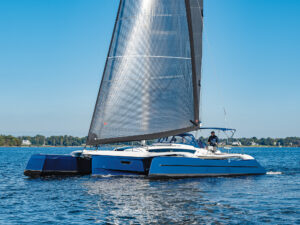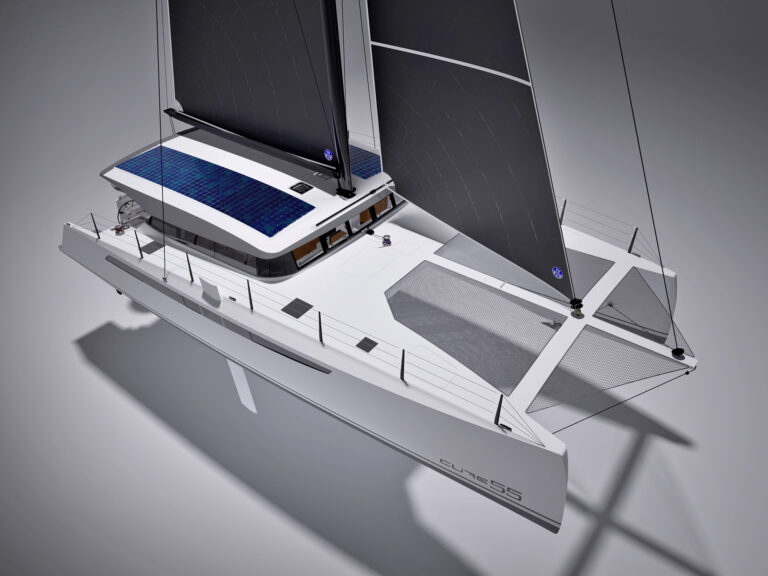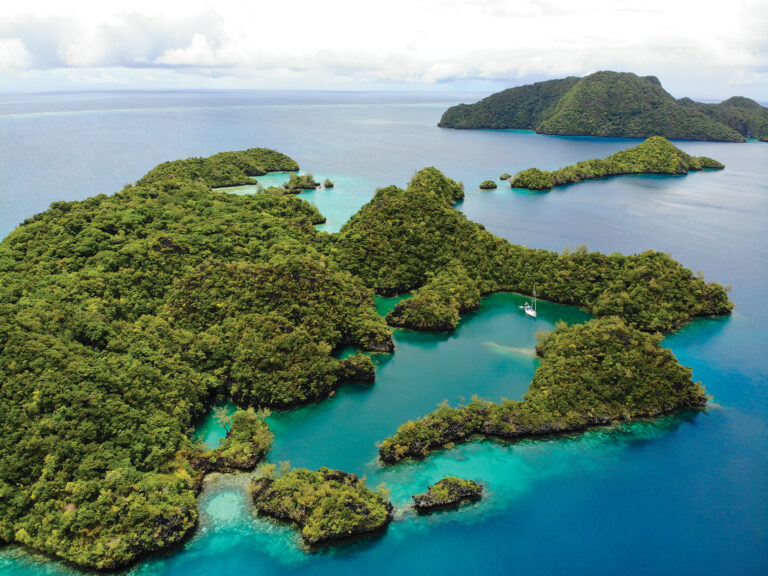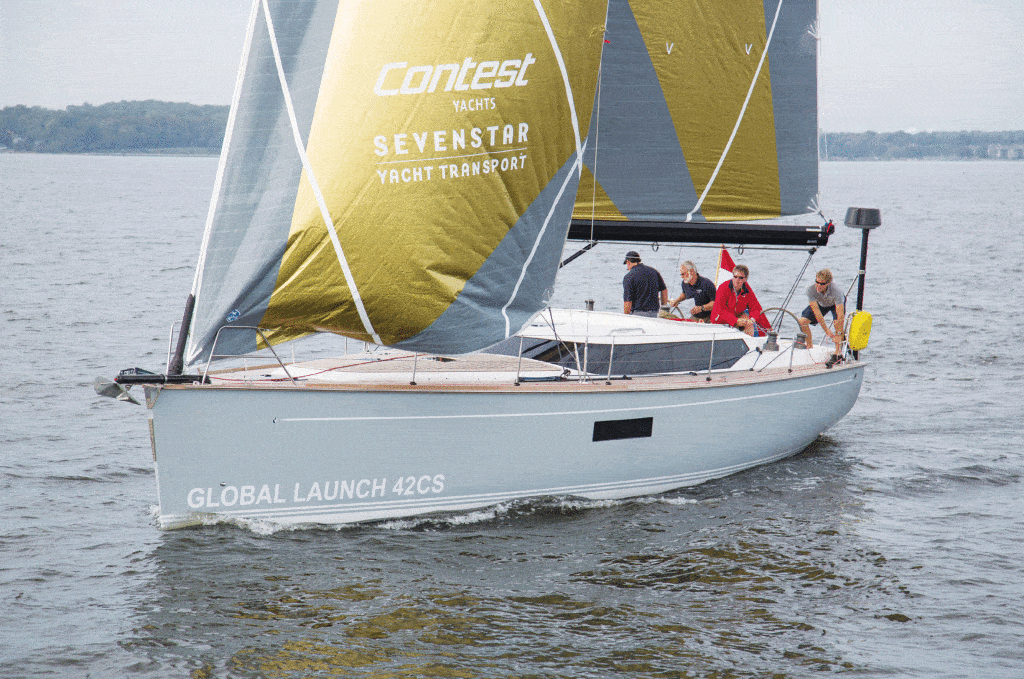
Contest 42CS
When CW‘s Boat of the Year judges sat down last fall and summed up their thoughts about the Contest 42CS they’d just taken for a spin following the U.S. Sailboat Show in Annapolis, Maryland, they grasped at superlatives to describe its build quality, hardware and, most important, sailing performance. Though they each used their own terms to extoll the boat’s virtues — and it has many — in the end they settled on two very simple phrases: Best Midsize Cruiser, 41-45 Feet, and Import Boat of the Year.
As BOTY judge Tim Murphy put it, “Boy, that boat really lit me up.”
Contest has been building sailboats at its three-generations-old, family-owned yard in Medemblik, Netherlands, since 1959. In recent years, the company has focused mostly on larger, center-cockpit cruisers, so the 42, with its aft cockpit, twin wheels, sleek-looking coach roof, wraparound tinted portlights, carbon-fiber rig and carbon-fiber retractable sprit is a step in a different direction.
Though it’s the smallest boat in the Contest range, which these days stretches to 72 feet, the 42’s price tag approaching $700,000 means it probably isn’t an entry-level sailboat (the U.S. importer, Berthon, notes the base price for the boat is $525,000). Still, says Contest managing director Arjen Conijn, it is intended for the family with children or perhaps older sailors who are trading down to their last boat. Accordingly, several deck and interior layouts are available to meet both lifestyle and sail-performance needs.
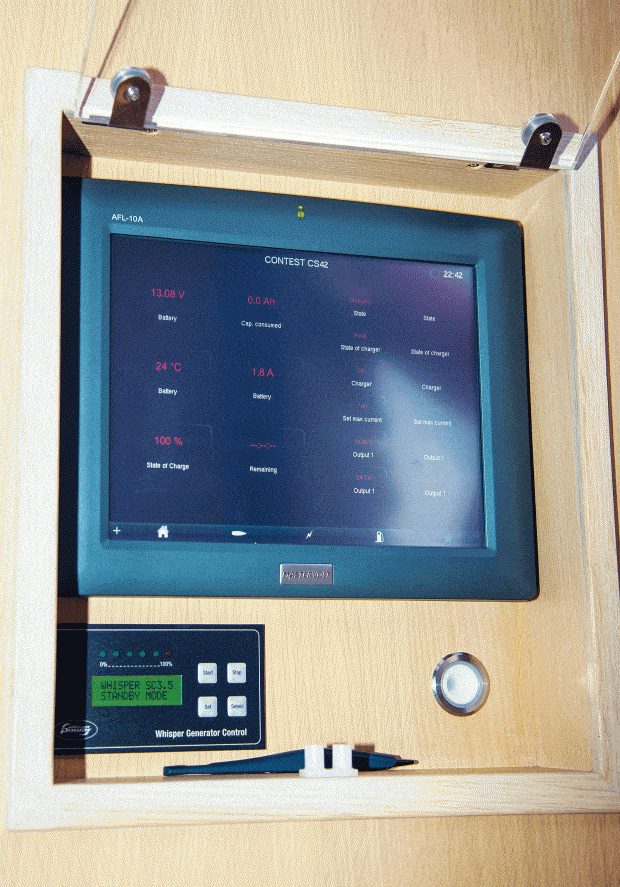
| |All electrical systems on the 42CS are controlled by a state-of-the-art Mastervolt digital switching system that’s administered by a touch screen mounted in the companionway.|
The boat we tested in Annapolis was purchased by an owner whose immediate plans were to hit the Caribbean racing circuit hard this winter and enjoy the cruising in between. Hence, we were blessed with North 3Di sails for our outing on Chesapeake Bay, and a performance package that included a full suite of B&G instruments, boom-end sheeting, a cockpit-wide traveler recessed in the sole just forward of the helms, four adequately sized Lewmar sheet winches (mounted two to a side on the coamings) and two cabin-top winches for halyards, reefing and other sail-control lines, and rod rigging (wire comes standard). In not a lot of wind, maybe 7 or so knots, the speedo hovered just above 5 closehauled, providing proof that the sail plan is plenty powerful. Under foot, the boat felt solid as a rock, thanks to its displacement/length ratio of 188. Both Murphy and BOTY judge Mark Schrader noted that the moderate displacement would be appreciated on long offshore passages in any sort of seaway.
Adjustable fairleads for the slightly overlapping 106 percent genoa keep the jib sheets close to the cabin house and out of the way; the German-style double-ended main sheet is led under the (optional) teak decks back from the mast, and either of its ends was easy for the helmsman to reach from either wheel. Speaking of the wheels, the steering was butter smooth, thanks to the Jefa rudder bearings and steering system controlling an infused-composite, fully balanced rudder. If there was one gripe — and there always is, even on the best-built boats — it involved the below-deck recessed Harken headsail furler, which was installed forward of the anchor windlass and would be quite difficult to reach should it need attention.
The deck layout includes two other possible designs: a cruiser model with mid-boom sheeting led to a winch on the cabin top and two jib-sheet winches on the coamings; and the singlehander, with two jib-sheet winches and one mainsheet winch that’s mounted on a pedestal between and just forward of the wheels.
The 42’s hull and deck are built using the company’s proprietary Conyplex vacuum infusion system. The laminate for the hull is solid fiberglass and vinylester resin to just below the waterline; from there up, it and the deck are balsa cored. While the hull’s still in its mold, an infused composite grid is bonded into it, as are the bulkheads; the hull-deck joint is both glued and fastened. Workmanship throughout the boat was excellent, the judges concluded.
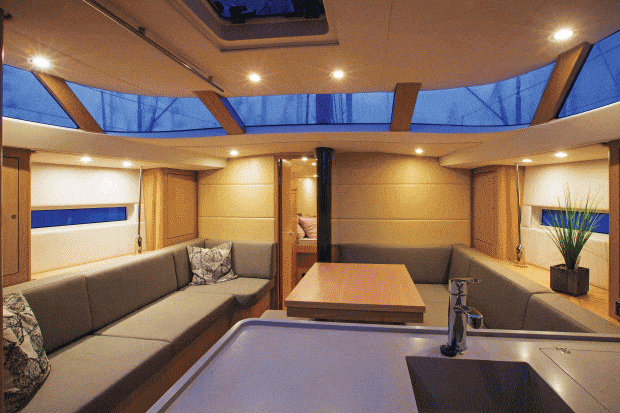
| |Styling in the saloon is modern, welcoming and functional. Note the two center strips of wood in the window on either side of the mast: Halyards and reefing lines are led from the base of the mast, under the deck, through channels hidden by the strips, and across the inside of the cabin top to winches by the companionway.|
Judge Ed Sherman noted that the installation of the boat’s Mastervolt electrical and other systems was top-notch, especially the digital switching system and touch-screen panel mounted in the companionway that control all electrical devices. He did, though, wonder about its location, which makes it a bit awkward to see and possibly prone to splashes from above.
Stepping below, the boat’s interior is quite modern and European in styling, but still warm and functional. The whitewashed European oak joinery (teak is an option) is offset by gray upholstery on the settee to port and the U-shaped dinette opposite in the saloon, and by gray Corian counters in the well-appointed galley. The boat we sailed had two double cabins aft (a single cabin to port and storage in the starboard cabin is an option, as is storage and a single berth in that same space). The owner’s cabin forward also comes in a couple of different layouts: a traditional V-berth with a head to one side of the cabin and a shower opposite, as on the boat we sailed, or a berth offset to starboard, with the head and shower in the forepeak. Berths throughout come with lee cloths installed.
From its distinctive looks to its lovely sailing qualities, the 42CS is a hard boat not to like. Sherman, sometimes stingy with his praise, began his thoughts by saying, “OK, well, this is probably my favorite boat this year.” He got no argument from the rest of us.
This article first appeared in the March 2014 issue of Cruising World. Click here for more Contest sailboats.


